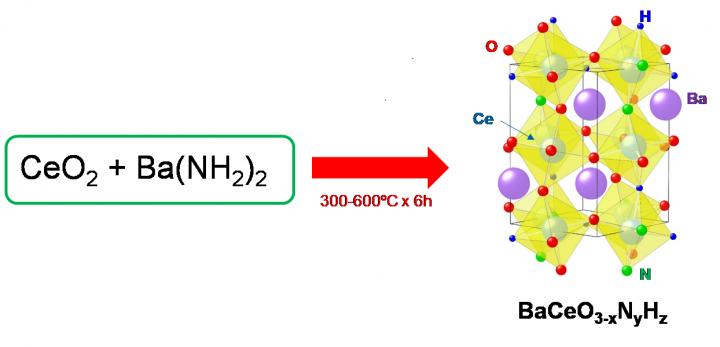Efficient bottom-up synthesis of new perovskite material for the production of ammonia

This new protocol for the production of BaCeO3?xNyHz can be carried out at much lower temperatures and in much less time compared with conventional methods. Credit: Tokyo Tech
Ammonia is a useful substance that can be employed in the production of fertilizers and artificial chemicals, and even as a clean-energy carrier (in the form of hydrogen), which may be key in eco-friendly technologies.
However, there are various challenges associated with the synthesis of ammonia and perovskites themselves.
The synthesis rate for ammonia is generally limited by the high energy required to dissociate nitrogen molecules. Some researchers have had some success using precious metals, such as ruthenium.
Recently, perovskites with some of their oxygen atoms replaced by hydrogen and nitrogen ions have been developed as efficient catalysts for ammonia synthesis. However, the traditional synthesis of perovskites with such substitutions usually has to be carried out at high temperatures (more than 800°C) and over long periods of time (weeks).
To address these issues, in a recent study carried out at Tokyo Tech, a group of researchers led by Prof. Masaaki Kitano devised a novel method for the low-temperature synthesis of one of such oxygen-substituted perovskites with the chemical name BaCeO3?xNyHz and tested its performance as a catalyst to produce ammonia.
To achieve this, they made an innovative alteration to the perovskite synthesis process. The use of Barium carbonate and Cerium dioxide as precursors (or “ingredients”) involves a very high temperature would be required to have them combine into the base perovskite, or BaCeO3, because Barium carbonate is very stable.
In addition, one would then have to substitute the oxygen atoms with nitrogen and hydrogen ions. On the other hand, the team found that the compound Barium amide reacts easily with Cerium dioxide under ammonia gas flow to directly form BaCeO3?xNyHz at low temperatures and in less time (Fig. 1). “This is the first demonstration of a bottom-up synthesis of such a material, referred to as perovskite-type oxynitride-hydride,” explains Prof. Kitano.
The researchers first analyzed the structure of the perovskite obtained through the proposed process and then tested its catalytic properties for the low-temperature synthesis of ammonia under various conditions.
Not only did the proposed material outperform most of the state-of-the-art competitors when combined with ruthenium, but it also vastly surpassed all of them when combined with cheaper metals, such as cobalt and iron (see Fig. 2). This represents tremendous advantages in terms of both performance and associated cost.
Finally, the researchers attempted to elucidate the mechanisms behind the improved synthesis rate for ammonia. Overall, the insight provided in this study serves as a protocol for the synthesis of other types of materials with nitrogen and hydrogen ion substitutions and for the intelligent design of catalysts.
“Our results will pave the way in new catalyst design strategies for low-temperature ammonia synthesis,” concludes Prof. Kitano. These findings will hopefully make the synthesis of useful materials cleaner and more energy efficient.
Media Contact
All latest news from the category: Materials Sciences
Materials management deals with the research, development, manufacturing and processing of raw and industrial materials. Key aspects here are biological and medical issues, which play an increasingly important role in this field.
innovations-report offers in-depth articles related to the development and application of materials and the structure and properties of new materials.
Newest articles

A universal framework for spatial biology
SpatialData is a freely accessible tool to unify and integrate data from different omics technologies accounting for spatial information, which can provide holistic insights into health and disease. Biological processes…

How complex biological processes arise
A $20 million grant from the U.S. National Science Foundation (NSF) will support the establishment and operation of the National Synthesis Center for Emergence in the Molecular and Cellular Sciences (NCEMS) at…

Airborne single-photon lidar system achieves high-resolution 3D imaging
Compact, low-power system opens doors for photon-efficient drone and satellite-based environmental monitoring and mapping. Researchers have developed a compact and lightweight single-photon airborne lidar system that can acquire high-resolution 3D…





















